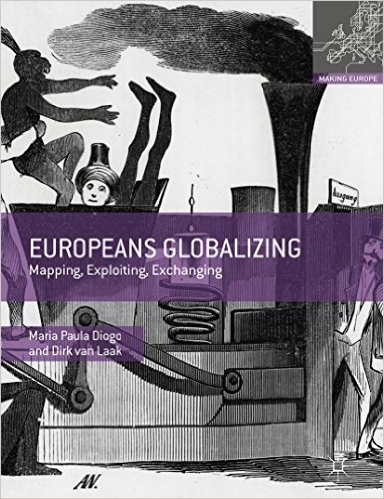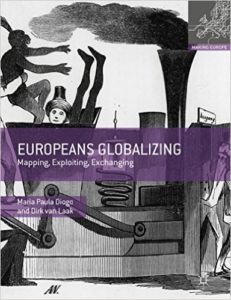
Europeans Globalizing: Mapping, Exploiting, Exchanging by Maria Paula Diogo and Dirk van Laak
 Europeans Globalizing is part of an ambitious research agenda that questions Europe’s history through a transnational history of technology. The book is the last volume in the Making Europe series (published by Palgrave Macmillan), which comprises six volumes covering the outcomes of a major international research collaboration that started in the late 1990s. These collaborations emanated from the pioneering work of the Foundation for the History of Technology (SHT), established at the Eindhoven University of Technology in 1988. It sponsored and hosted the Tensions of Europe Network, which since 1999, has been a platform facilitating and coordinating European research projects, most significantly the Inventing Europe project that ran between 2005 and 2011, and was funded by the European Science Foundation.
Europeans Globalizing is part of an ambitious research agenda that questions Europe’s history through a transnational history of technology. The book is the last volume in the Making Europe series (published by Palgrave Macmillan), which comprises six volumes covering the outcomes of a major international research collaboration that started in the late 1990s. These collaborations emanated from the pioneering work of the Foundation for the History of Technology (SHT), established at the Eindhoven University of Technology in 1988. It sponsored and hosted the Tensions of Europe Network, which since 1999, has been a platform facilitating and coordinating European research projects, most significantly the Inventing Europe project that ran between 2005 and 2011, and was funded by the European Science Foundation.
Europeans Globalizing is as inspiring as it is bewildering, mainly because of the sheer scope of the book and its transnational ambitions. The authors, Portuguese historian of technology Maria Paula Diogo, and German historian Dirk van Laak, aim for a transnational history of technology of Europe’s global relations since 1850. At first view, a technological account of European expansion might seem an extension of William McNeil’s The Rise of the West, which, including its reiterations by David Landes, Niall Ferguson and others, established a narrative of European global dominance based, among other things, on superior technology. Europeans Globalizing, however, argues that technology should be even more central, implying the overbearing emphasis on culture in the traditional Eurocentric account. The authors argue that from the late eighteenth century, European expansion was increasingly guided by the urge to civilize and develop, based on the tenets of science and industrial capitalism. Although light on conceptual reflections about their transnational ambitions, the authors emphasize the importance of including non-European historiography, arguing that Europe was as much shaped by its internal dynamics as it was by the ways that (once) subjugated peoples and territories resisted, adopted, adapted, and reciprocated European knowledge and technology. The Europeanization of the world was mirrored by the globalization of Europe.
Because of the sheer scope of the topic, the authors have chosen a palette of stories that illustrate the broad pattern of interactions without losing the variety of different experiences both geographically and temporally. The book’s underlying periodization is based on the changing relationship between Europe and the world, starting with the mapping of the world outside Europe from the fifteenth century on, to exploitation in the age of imperialism, and finally to less coercive but not necessarily more equal exchanges during and after decolonization. The authors have not explicitly forced this periodization upon the structure of the book, and the chapters are mostly regionally or thematically organized with a loosely applied chronology. Storylines started in the first chapter are not returned to before the last chapter, for instance, whereas the case of Japan returns several times with some overlap. This makes navigating the book challenging, and it is not always easy to keep track of a particular story that is spread out over a number chapters.
The first chapter discusses European exploration and associated innovations in measuring, mapping, classifying, and analyzing everything they encountered. The chapter lays out the mental trajectory of European expansion. The authors return several times to the motivations behind the European penchant for mapping, categorizing, and experimenting: “an unremitting spirit of classification, standardization, measurement, and calculation” (35), “work” as the core European virtue (36) and “a fundamental curiosity” (54). Such classifications invoke the cultural strain of Eurocentric accounts, but Diogo and Van Laak argue that underlying these supposed European traits was a technological and scientific worldview that reinforced itself over time. Discovering, mapping, and mastering unknown territory became a goal of its own, encouraged by imperialist and nationalist interests and sentiments.
Discovery and mapping brought opportunities for exploitation and exchange. Besides a familiar account of the problems faced by the likes of (Soviet) Russia, the Ottoman Empire, and Japan in absorbing European technology without threatening political or cultural autonomy, the second chapter discusses the double-edged sword of the colonial and imperial enterprise as the diffusion and exploitation of crops and commodities. Europeans were prolific prospectors and experimenters, but the increasing dependence of industrializing Europe on these colonial crops and products—meat, sugar, bananas, rubber, and guano to name just a few—also created problems of supply and control. In some cases, technology was applied to secure and strengthen supply chains. In others, dependence was substituted for technological innovation, most famously in the case of Germany’s breakthroughs in synthetic fertilizer and rubber. European exploitation of, and exchange with, the outside world therefore gave rise to technologies that both strengthened and disrupted its external relations. Europe’s closest relations, however, were forged with the US. The Atlantic formed a reciprocal “sphere of technological innovation” (95) that produced an astonishing number of innovations during the nineteenth and twentieth century.
The third chapter comprises the darker side of European expansion—the technologies of war. Luckily the chapter is not a reprise of the voluminous literature on the military technologies of war, but rather discusses how the increasing destructiveness of these technologies fostered the co-evolution of science and technology to contain and soften war’s impact on man, including the improvement of health care on the battlefield, international law, and other “technologies of peace” (126). However, technological progress and societal efforts to domesticate its impact were frequently out of sync, and only the nuclear standoff during the Cold War created a balance between deadly weaponry and contained warfare. Nonetheless, these efforts to contain the impact of war did not extend to Europe’s colonies, where experimentation with new weapons and tactics, and a lack of restraint were fueled by racism. The discrepancy between the discourse of constraint, as applying to Europeans and the brutality faced by the colonized, fostered doubt about European (moral) superiority and stoked the fire of the independence movement across colonies in the interwar period.
Something that is conspicuously missing from the third chapter—that Europe’s division marked its penchant for war and arms races, which made for major military conflicts over colonial territories—is remedied in the fourth chapter, where the discussion shifts to the pivotal importance of infrastructure in the scramble for Africa. Infrastructure was the backbone of high imperialism, and as each colonizing nation attempted to strengthen its hold over its colonial territories, trans-African infrastructural projects gave rise to several competing and overlapping networks of rail, telegraph, and road, each representing the nationalist sentiments of high imperialism. Sometimes these nationalist impulses clashed, as in the the Fashoda Incident in 1898. Diogo and Van Laak provide an interesting comparison between Cecil Rhodes’ “all red” Cairo-to-Cape Town infrastructure project, and the similar but less known Portuguese Pink Map project seeking to build a Portuguese bridgehead across sub-Saharan Africa connecting Mozambique and Angola. The infrastructural unlocking of Africa then gave rise to a specific model of exploitation, which, as Diogo and Van Laak argue, came to its most extreme variant in South Africa. Finally, the chapter addresses the mindboggling (and unrealized) plans for trans-Mediterranean infrastructure connecting North Africa and Europe accompanying the various iterations—mainly French and German—of the idea of Eurafrica.
The fifth chapter discusses the spread and subsequent adoption of Western technology in Asia in the nineteenth and early twentieth century. The authors propose two factors that determined the distinct patterns of diffusion and adoption in India, China, and Japan. Firstly, the initial position of these societies vis-à-vis the European empires determined the conditions under which Western technology was introduced. Colonial India had little ways of resisting; weakened China found itself outgunned and forced to concede access; only sovereignly independent Japan could dictate the terms and shape its own pattern of adoption. Secondly, the authors propose that the extent to which Western technology became the bedrock of a new society determined the pattern of development in the post-colonial era. The Indian railroad was transformed from the hallmark of imperialism into an instrument of nationalism. Japan’s Meiji Restoration adopted Western science and technology as the foundation of a new society, facilitated by the country’s long history of interest in and selective adoption of Western technology. Meanwhile, China took an instrumental view of Western technology, adopting it only to match Western firepower in a futile attempt to stave off Western domination and culture.
The sixth chapter moves on to discuss decolonization and the role of Western technology in post-colonial societies, asking, “what is left after the Europeans have gone?” (242). The authors argue that European science and technology, and the international institutions and standards regimes it spawned, provided the infrastructure of commerce and empire, but also provided a vital layer supporting the post-colonial new world order. Yet, according to the authors, the significance of “technology remains paradoxically outside mainstream versions of the colonial legacy” (213). To make the point, the authors argue that it was this global network of institutions and technology that enabled Wilsonian moments sparking anti-colonial movements across Asia and North Africa. Whereas European technology spawned a global system of communication and exchange, its colonial and imperial dependencies did not die with decolonization. Within postcolonial states, the European technological inheritance led to a wide array of developmental trajectories, with growth taking off in some nations while others stagnated and declined, both dependent upon and independent from former colonial powers.
The final chapter picks up a thread started in chapter three, discussing the downfall of European empires at the hands of the devastations and shattered illusions following two World Wars. The Cold War divided and weakened Europe on the global stage but simultaneously fostered the birth of a new technologically vibrant Western Europe and reinforced the spread of a “Western cultural package” (250) primarily at the hands of American preeminence and assistance, as in the case of Israel. This package fostered new technologies and cultures of mobility. Simultaneously, many postcolonial societies faced continued dependency and a sometimes viciously resource-oriented neo-imperialism as witnessed most strikingly in the Congo. Here, nascent self-rule under Patrice Lumumba was snubbed out with US support and substituted with decades of dictatorial rule and a chronic civil war.
The wide scope of the book can be boiled down to four broad themes of technological interaction between Europe and the rest of the world. One such theme is the contrast between a European self-image of spreading civilization by means of technology and the often negative and exploitative results of its application. A second theme is the recurring dream of a peaceful, technologically unified world, while the realities of the stratified and disparate nature of global integration time and again refuted it. A third theme is the wide variety of outcomes of how European technology was adopted by non-European societies, depending on whether these technologies were resisted, creolized, or systemically integrated. A fourth theme is the European-ness of European technology, particular in relation to its increasingly powerful partner across the Atlantic. Each theme involves a discrepancy between dream and reality, objective and outcome, self-image and its mirror reflection. Eurocentrism, argue the authors, is an outcome of this sobering process of reflection on European identity in a globalized world. This reflexive approach to European identity seems timely with populist nationalism on the rise across Europe and the US.
Despite its bewildering palette of stories, the range and scope of the book as well as the thoughtfulness with which the authors discuss their disparate topics are impressive. The inescapable problem of selection, however, does have several victims. As the authors concede in the epilogue, their ambition to include non-European historiography remains largely unrealized. A second victim is the historical actor, whether as individual, company, or organization. Entrepreneurs and firms, for instance, are conspicuously absent, even though much of the infrastructure, arms and technological applications that made up the ‘Western cultural package’ penetrated distant societies at their hands. Part of the problem might be the authors’ ambition to tell new stories instead of rehashing well-known ones. Nonetheless, the transnational approach provides a refreshing perspective on Europe’s identity and connections to the world. It is a welcome and important contribution to the literature on Europe’s place in the technological Great Divergence.
Reviewed by Marten Boon, Norwegian University of Science and Technology
Europeans Globalizing: Mapping, Exploiting, Exchanging
by Maria Paula Diogo and Dirk van Laak
Publisher: Palgrave Macmillan
Hardcover / 302 pages / 2016
ISBN: 9780230279636
To read more book reviews, please click here.
Published on April 4, 2017.




